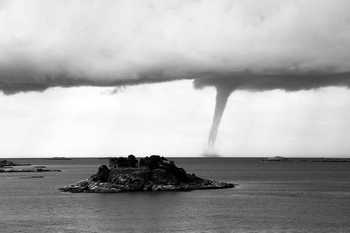For the 2022 Northern Hemisphere hurricane season from June 1 to November 30, the U.S. National Oceanic and Atmosphere Administration (NOAA) is forecasting an above normal Atlantic hurricane season with a 65% probability of 14 to 21 named storms (sustained winds of 39 mph or higher). Of these storms, NOAA forecasts 6 to 10 could become hurricanes (sustained winds of 74 mph or higher), which includes 3 to 6 major hurricanes classified as category 3, 4 or 5 with winds of 111 mph or higher.
And business leaders are once again asking themselves: Is my company prepared?
Often, the answer is “no.” Despite total annual U.S. hurricane damages now regularly exceeding $100 billion, the majority of businesses remain insufficiently protected against hurricane-related catastrophes. Even among the Fortune 1000, more than 50% of companies delay preparation efforts until the first-named storm of the season — and that approach can be costly, not only in terms of immediate wind and water damages, but in terms of a company’s business continuity, reputation, and long-term profitability.
So, what can companies do to help minimize their exposure to risk?
The first step is to establish a comprehensive risk assessment and response framework before a storm is on its way. The initial assessment must account not only for the impact of a storm on facilities and equipment, but also for any potential vulnerabilities across the company’s full operational structure — including its workforce, its supply chain, and its data and technology systems. Once vulnerabilities have been identified, contingency plans can be developed or refreshed.
Regardless of where your company stands in its preparations for hurricanes and other natural disasters, there are immediate steps business leaders can take to address short-term damages and pave the way for faster recovery.
Preparing for the Immediate Impact of a Storm
Most companies understand the importance of securing their physical facilities and equipment against immediate flooding and wind damage. However, far fewer companies comprehend and plan for the more complex challenges that can arise from widespread power outages, impassable roads, closed bridges, and manpower shortages from wide-scale evacuations. Depending on a hurricane’s strength, the severity of such outcomes can be unpredictable, and their total impact on a business can often outweigh immediate damages.
Hurricane Maria, which flattened Puerto Rico’s infrastructure, demonstrates that even seemingly prepared companies can be caught off-guard. Following that storm, local and multi-national businesses faced significant issues ranging from challenges feeding livestock to the inability to resume manufacturing operations. These issues were largely the result of common, predictable disruptions such as:
- The inability to communicate with employees due to power outages and damaged communications infrastructure.
- Roads that were impassable, severely limiting supply chain routes, which meant critical food, water, and other supplies could not reach businesses and homes.
- Roads that were impassable, severely limiting supply chain routes, which meant critical food, water, and other supplies could not reach businesses and homes.
It is not enough to have just one response plan — companies must prepare for as many “worst-case” scenarios as they can, accounting for disruptions to their operations, facilities, and inventory. Considerations should include investing in reliable back-up power sources to counter the impact of long-term power outages. Companies must also assess their data storage, access, and usage, all of which could be impacted by outages, equipment damage, and opportunistic hacking. Traditional communication options, such as cell phones, landlines, and the internet, could be down for extended periods of time. Alternative forms of communication should be established prior to a storm’s arrival. These efforts will help maintain safety for personnel and facilities, after evacuations have been completed.
Protecting Your Workforce
Following a storm, accounting for damages to employees’ homes and personal property is extremely important. In hurricane-prone areas, many employees will likely experience the significant emotional and financial toll of seeing their homes and assets damaged or destroyed. To lessen the burden, companies should plan for temporary housing for employees and ease the access to water and food. Reports after 2005’s Katrina and other major hurricanes showed that companies that brought in temporary housing trailers for their displaced workers and their families were able to regain operational status more quickly.
Furthermore, damaged broadband infrastructure can disrupt traditional communication channels, such as e-mail, leaving companies scrambling to get in touch with employees and ensure their safety. As a proactive measure, companies should consider facilitating tracking software for employees to use that can help them find employees during search and rescue operations. Partnering with third-party security providers can add an extra layer of safety during such operations; trained personnel can more readily navigate damaged roads and facilities to ensure that critical supplies are successfully delivered to employees.
Addressing Supply Chain Disruptions and Economic Vulnerabilities
The economic impacts of hurricane damages often extend well beyond the immediate hurricane zone. Following Katrina, the damage in New Orleans caused widespread disruptions to supply chains throughout the region and beyond, from the Gulf of Mexico to Minneapolis. During and after Harvey, the shutdown of major refineries near Houston — which typically processed 2.6 million barrels of crude oil per day — significantly impacted the total refining capacity, not only of Texas, but of the entire United States.
In the immediate aftermath of a storm, the integrity of a company’s operations and supply chains are likely to be impacted by manpower shortages, power outages, fuel shortages, intermodal transport accessibility, and truck shortages. In the days and weeks following a storm, supply chains can be vulnerable to second-degree damages, such as erosion or destruction of transportation infrastructure from flooding, cost spikes in the logistics sector due to truck and chassis shortages, and wholesale and retail fuel prices. In the longer term, increased insurance premiums and electricity rates can take a toll on the bottom line.
Companies whose supply chains are exposed to hurricanes should consider these threats and take steps to combat them, such as identifying alternate transportation routes, stockpiling surpluses of essential materials in advance of a vendor plant closing, and factoring in increased long-term costs in hurricane-prone regions.
Getting Back to Business
After a hurricane, your company may rely on an insurance payout to get up and running again — but the speed of that payout will depend on how quickly your company can file the claim and provide the insurer with all necessary information. That means tracking and collecting necessary data during a crisis and filing it as quickly as possible.
While data collection and insurance filing may not seem like priorities during a storm, staying on top of these administrative requirements can significantly improve a company’s ability to recover afterward. Data from previous hurricanes indicates that businesses that are proactive about these seemingly mundane procedures receive faster insurance payouts, allowing them to resume their operations more quickly. Particularly for companies operating in highly competitive markets, that recovery time can be crucial in reestablishing or defending your business against competitors.
Developing a Total Risk Perspective
If you’re thinking about your company’s hurricane risks (or any natural disaster risks) ahead of time, you’re already on the right track. But to ensure your crisis response plan is as strong as it can be, it’s important to involve relevant specialists from across your organization — including security, IT, insurance, and human resources — in all risk-assessment and response-development exercises. While this may seem cumbersome — particularly for larger organizations in which these functions operate in silos — the unique insights that these specialists can provide are invaluable, and the resulting contingency plans tend to be significantly stronger, allowing companies to more successfully navigate the extreme pressures of a crisis.
Once strong hurricane response plans have been established, it’s crucial that every employee in every division is on the same page regarding how those plans are executed. Companies should familiarize employees with all necessary aspects of their response plans, conducting drills and scenario planning exercises that are tailored to employees’ particular roles within the organization. These exercises can often have the added benefit of helping companies identify unanticipated gaps or vulnerabilities in their plans, allowing them to further refine their plans in advance of a storm rather than in its aftermath.
Response plans should be communicated across the full organization, ensuring that all employees are fully aware of their role and responsibilities. Hurricane responses can be chaotic if efforts are not streamlined or if individuals are not sure what to do. Communicating and stress-testing plans well ahead of time can help minimize employees’ uncertainty during a crisis and improve their chances of making the right decisions in the heat of the moment.
Response plans should be communicated across the full organization, ensuring that all employees are fully aware of their role and responsibilities. Hurricane responses can be chaotic if efforts are not streamlined or if individuals are not sure what to do. Communicating and stress-testing plans well ahead of time can help minimize employees’ uncertainty during a crisis and improve their chances of making the right decisions in the heat of the moment.
Note: This article was originally published on Security Today (1). It has been updated for 2022 and reposted on the Pinkerton website.





